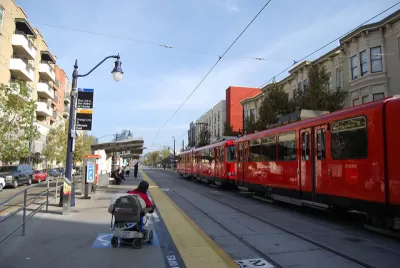Activists organized to save their downtown San Diego neighborhoods from the NFL Chargers' stadium proposal. Their defense strategy? A fine-grained community plan with no stadium. In the process, they came upon the idea of a promenade and a "Nudillo."

A group of community activists calling themselves the "Village People" have initiated a grassroots planning effort in the East Village of San Diego's downtown. The East Village area was repeatedly characterized as a wasteland by the NFL Chargers and their supporters, when their owner, Dean Spanos, and his consultants were trying to convince the city to build them a new stadium there. These activists showed the voters that the area had value and potential without a stadium. They held well-attended community workshops and out of that effort came some interesting ideas. They created a vision of what the area could become if spared the stadium bulldozers. They put the vision in a draft document called the East Village South Focus Plan.
Among the ideas coming from this effort was a pedestrian promenade through the heart of the would-be stadium site. The promenade would create a connection between downtown and Barrio Logan at a junction where the respective communities' different street grids abut. At this juncture, the promenade would take a slight turn, which they named the "Nudillo" (or knuckle). It would be marked with a landmark such as an obelisk and perhaps a round-a-bout. The Chargers derided the community vision as "airy-fairy," touting their stadium plan as vastly superior for the downtown. Nevertheless, the voters rejected the Chargers stadium, Dean Spanos moved his team to Los Angeles, and the Village People are now holding additional workshops to refine the promenade and Nudillo concepts. Michael-Leonard Creditor, a local design activist, attended the first workshop. He shares his photos and impressions in the source article.
FULL STORY: A New Grand Pedestrian Promenade Through Downtown San Diego?

Maui's Vacation Rental Debate Turns Ugly
Verbal attacks, misinformation campaigns and fistfights plague a high-stakes debate to convert thousands of vacation rentals into long-term housing.

Planetizen Federal Action Tracker
A weekly monitor of how Trump’s orders and actions are impacting planners and planning in America.

In Urban Planning, AI Prompting Could be the New Design Thinking
Creativity has long been key to great urban design. What if we see AI as our new creative partner?

King County Supportive Housing Program Offers Hope for Unhoused Residents
The county is taking a ‘Housing First’ approach that prioritizes getting people into housing, then offering wraparound supportive services.

Researchers Use AI to Get Clearer Picture of US Housing
Analysts are using artificial intelligence to supercharge their research by allowing them to comb through data faster. Though these AI tools can be error prone, they save time and housing researchers are optimistic about the future.

Making Shared Micromobility More Inclusive
Cities and shared mobility system operators can do more to include people with disabilities in planning and operations, per a new report.
Urban Design for Planners 1: Software Tools
This six-course series explores essential urban design concepts using open source software and equips planners with the tools they need to participate fully in the urban design process.
Planning for Universal Design
Learn the tools for implementing Universal Design in planning regulations.
planning NEXT
Appalachian Highlands Housing Partners
Mpact (founded as Rail~Volution)
City of Camden Redevelopment Agency
City of Astoria
City of Portland
City of Laramie




























